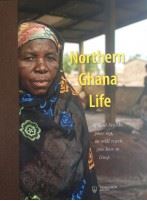Northern Ghana life : if God breaks your leg, he will teach you how to limp
 The photos in this book show that Northern Ghana is a society in continuous change. The images offer a shift in perspective to those who are not acquainted with the region. Foreigners tend to see 'Africa' as a backward continent, with persisting traditions that do not give way to modernity and change, plagued by bloody con icts and diseases. Such deep-rooted prejudices narrow one's perspective. It is only with an open mind that one is able to observe the dynamic realities, such as a rapid incorporation of (mobile) technologies and a growing middle class with its own particular ambitions. It is only when one appreciates these developments that one can learn from them. The constant change should invite the foreign visitor to wonder, study, and learn continuously, instead of jumping to conclusions too quickly about what ought to be done to spur development. Northern Ghana has its own, very particular trajectory of development with ample possibility to inspire any visitor.
The photos in this book show that Northern Ghana is a society in continuous change. The images offer a shift in perspective to those who are not acquainted with the region. Foreigners tend to see 'Africa' as a backward continent, with persisting traditions that do not give way to modernity and change, plagued by bloody con icts and diseases. Such deep-rooted prejudices narrow one's perspective. It is only with an open mind that one is able to observe the dynamic realities, such as a rapid incorporation of (mobile) technologies and a growing middle class with its own particular ambitions. It is only when one appreciates these developments that one can learn from them. The constant change should invite the foreign visitor to wonder, study, and learn continuously, instead of jumping to conclusions too quickly about what ought to be done to spur development. Northern Ghana has its own, very particular trajectory of development with ample possibility to inspire any visitor.
Includes a chapter by Manon Stravens and Ellen Mangnus. Photographs by Dennis Akuoku-Frimpong, Abdulai Adam, Peter DiCampo, Eric Gyamfi, Francis Kokoroko, Bénédicte Kurzen, Gerard Nartey. Francis Nii Obadai Provencal and Patrick Willocq.
Author(s) / editor(s)
About the author(s) / editor(s)
Michel Doortmont, a historian, is seconded (part-time) to the ASCL from his position as Reader in International Relations and African Studies at the University of Groningen for the period 2015-2019.
At the ASCL he manages the research programme Society and Change in Northern Ghana: Dagomba, Gonja, and the Regional Perspective on Ghanaian History. In this programme the ASCL collaborates with the University of Ghana at Legon and the University for Development Studies in Tamale and Wa, Ghana, as well as the University of Groningen, in the development of new research and capacity building in the field of regional history. The programme also includes a photographic documentation project, developed in cooperation with Noorderlicht Photography (www.noorderlicht.com)

